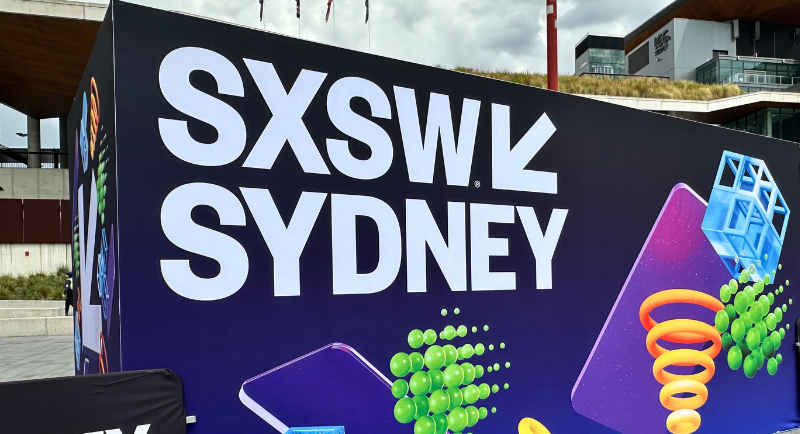By James Manning, Alisha Buaya and Jasper Baumann
SXSW Sydney 2024 kicked off with a literal bang as a clap of thunder (and passing heavy rains) momentarily forced attendees out of Tumbalong Park, which was dotted with activations and experiences.
Creatives, innovators, and leaders from across a range of industries were among the many to flock to the ICC for a day of panel discussions and presentations.
By the afternoon, the rain cleared, and attendees were back on the ground checking out the different houses and sites.
Mediaweek was on the ground to see the action at SXSW. Check out the highlights:
Meet the Influenceables
James Boardman, Wavemaker’s chief strategy officer, welcomed marketers to a session with Felipe Thomaz, associate professor of marketing at Saïd Business School at the University of Oxford, that examined influencability and the direction of consumer decision making.
Boardman said: “What we wanted to do was find out what secrets hide inside that information if you were to aggregate all of that data and see what it told us about how people make decisions.”
Thomaz asked SXSW attendees to remember the when it comes to influenceables and audience response “heterogeneity matters”. He said that the industry needs to move away from effectiveness efficiency and to not just ask if a channel works but also ask how it works and what was done to bring them into the channel.
Rounding out his takeaway points, Thomaz said there is no right or wrong channel mix – “Channel mixes work differently on different metrics – start with that and scale vs. the other way around.” – AB
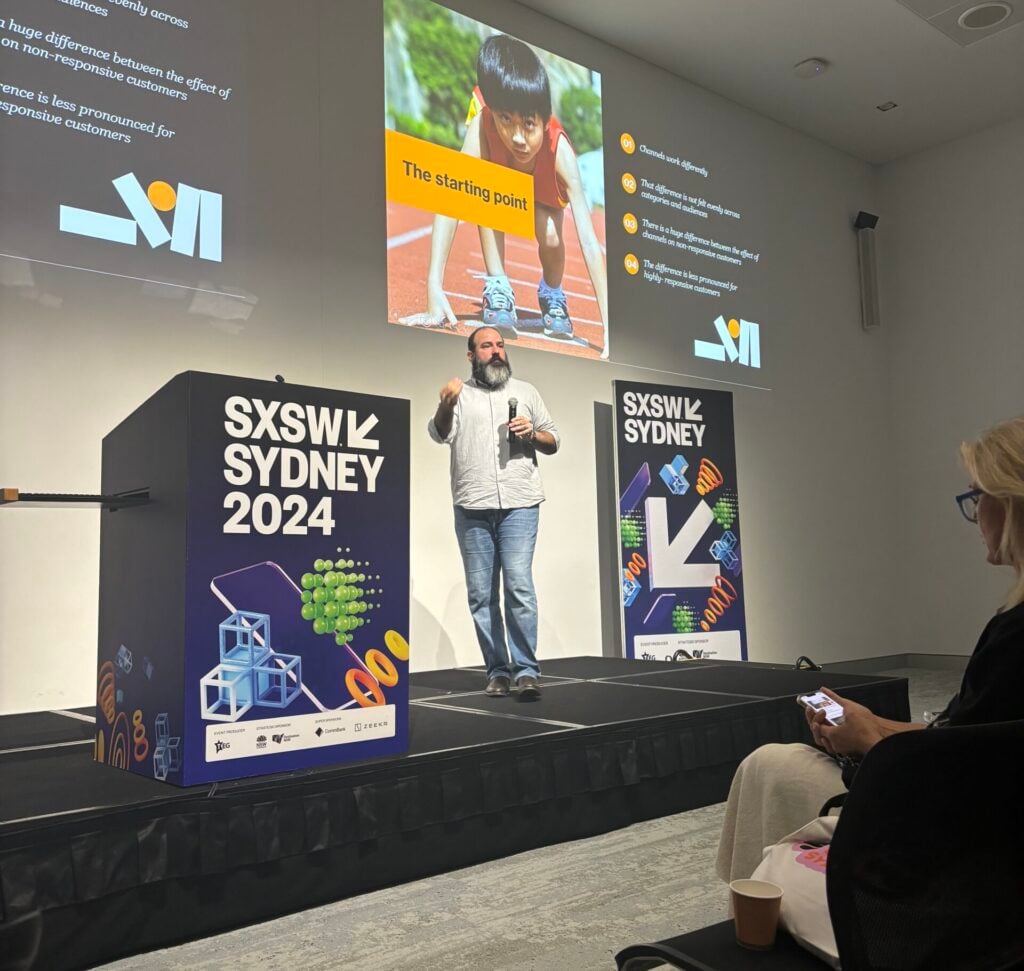
Felipe Thomaz
Intuit Mailchimp’s ‘Email is Dead’ experience

Mediaweek took a tour of Mailchimp’s experience, ‘Email is Dead’, in Tumbalong Park, following the success of its exhibition at the Design Museum in London in 2023. The bright yellow structure was constructed over two weeks by Mailchimp’s in-house agency Wink Creative and Sydney-based creatives Studio Messa.
The walk-through activation begins with a gallery of emails that highlighted its impact as a communication medium over the years and in the lives of people all over the world. This included correspondence from Annie Lennox and the email of how Airbnb was first conceived.
As guests walk through the activation, they will be met with a bespoke soundtrack showcasing the sound of email, a curated small designed to replicate a sense of connection that email can generate, and its AI machine Freddie. Before leaving, attendees can enjoy a moment of reflection in a mirrored space before stepping back into the hustle and bustle of SXSW.
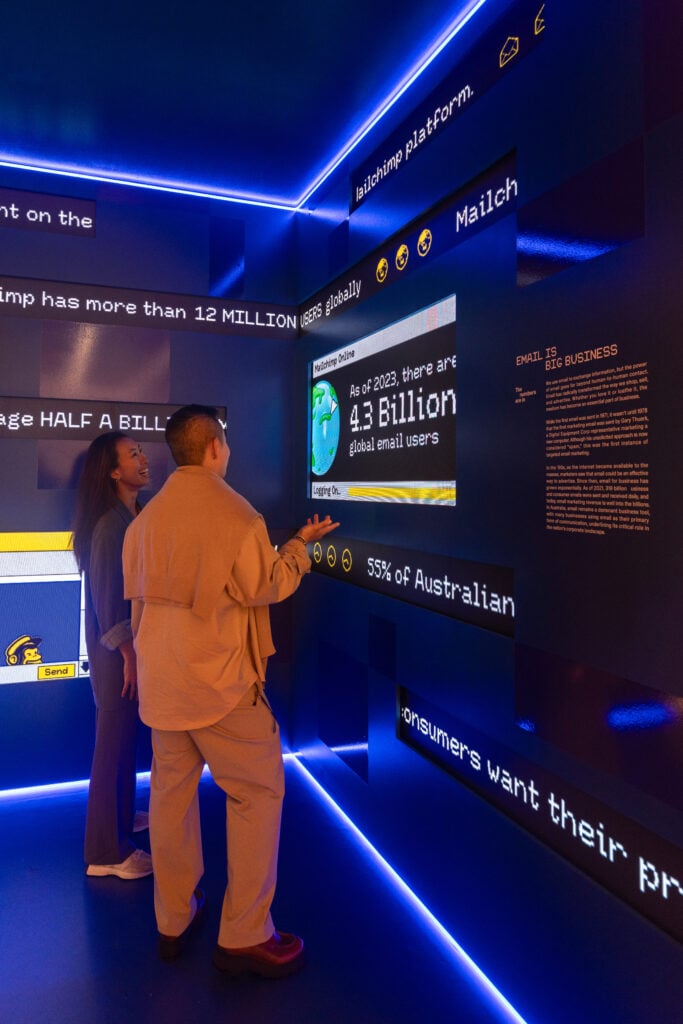
Michelle Taite, chief marketing officer at Intuit Mailchimp, said: “Email is anything but mundane—it’s a deeply personal, universally connecting force that has shaped our world for decades. With this experience, we invite visitors to explore the eternal influence of the inbox and join us in celebrating email’s past, present, and AI-powered future. Is email dead? Not even close,” says
Trey Wadsworth, creative director, Intuit Mailchimp & Wink Creative, said: “We’ve taken something as universal as email and transformed it into an interactive experience bringing email’s evolution to life in a way that’s both surprising and inspiring. By weaving in local cultural nuances, we’ve made sure this experience connects deeply with the Australian audience, where email marketing continues to thrive with engagement rates double the global average.” – AB
APAC’s Marketing Masters: The Best of the Best
AANA CEO Josh Faulks welcomed attendees to hear from the leaders of Arnott’s and Uber about the secrets behind their award-winning campaigns.
Saatchi & Saatchi Australia and The Neighbourhood’s Toby Aldred and Arnott’s CMO Jenni Dill discussed their ‘How Little Moments Made Big Bikkies’ campaign, and what they did to secured them the prestigious Grand Effie.
They revealed the four strategic principles behind the campaign: advertising effectiveness – the relentless focus on top-of-funnel emotion, consumer insight – the focus on moments on which people put a premium on post-Covid, brand insight – reigniting rituals and incominc moments for fast-acting (price-sensitive) relief, and campaign architecture – a modular, masterbrand campaign with hero SKU’s covering sweet and savoury products across the day.

Toby Aldred and Jenni Dill
Uber CMO Andy Morely and Celia Garforth, head of strategy at Special spoke about scaling Uber and Uber Eats in Australia and across APAC over the last seven years. They discussed how they navigated complex cultures from Sydney to Japan and built relevant campaigns with creative and powerful brand strategies.
Garforth said: In the last few year, we really pivoted to a much more localised humour and communication stye in Japan. This is very much working for us, we launched this brand campaign back in April, we were instantly voted most loved brand in Japan for the next three months.”
However she noted that the campaign was knocked off this month by Nissin’s instructional ad for its Egg noodles, which she played for attendees to their delight. “It’s very literal, it’s very direct, and the supers that are playing on top quite literally explain how to cook the noodles.”
Morely, while surprised their successful campaign lost it’s three-month reign, said: “there is a cultural hook in there that none of us would get.” – AB

Toby Aldred, Celia Garforth, Andy Morely and Jenni Dill
Australia 2035 – Are You Ready For What’s Coming?
ABC’s David Speers lead a discussion with Rose Herceg, president of WPP Australia and New Zealand, and Katie Rigg-Smith, chief strategy officer for WPP in Australia and New Zealand about the duo’s recent study, Secrets and Lies, that uncovered the hopes, fears, aspirations and desires for Australia in 2035
The conversation spanned education systems, the new generation entering the workforce, communities, family structures, AI, the value of money and the impact of cancel culture on free speech and the importance of creativity and imagination in a business.
In the Q&A portion, a member of the audience asked the WPP leaders about the agency’s work with fossil fuel clients and the impact of climate change despite authoring a report on the future on the future of Australia.
Though the question drew murmurs from the crowd, Herceg said: “With those client’s were trying to help them with the transition to renewables, where possible.”
She noted that there are plans to transform these clients, but as a number of them were not Australian clients, she could not specifically comment on those plans. – AB
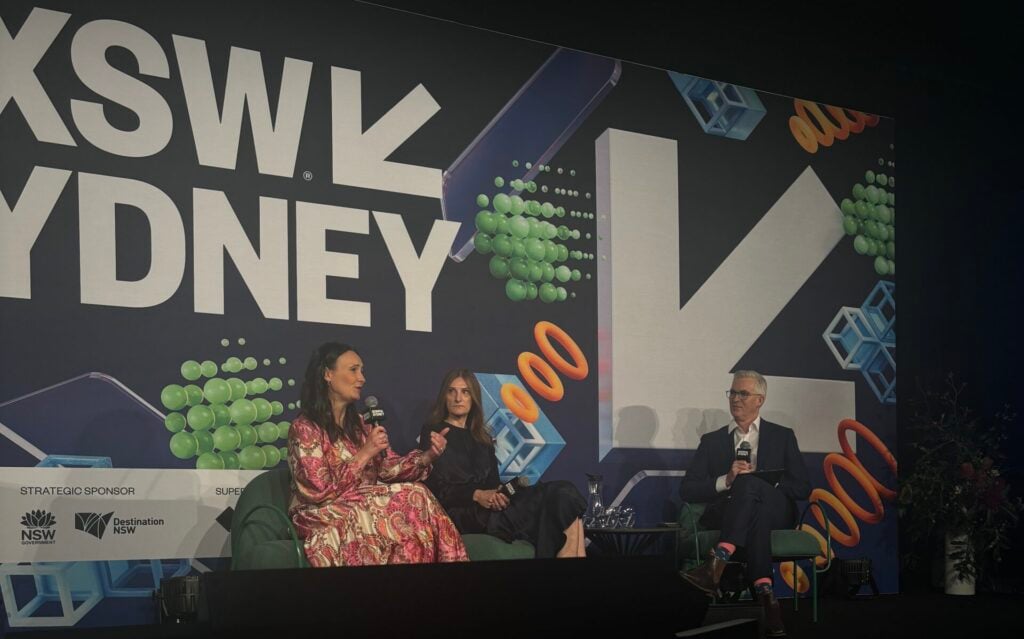
Katie Rigg-Smith, Rose Herceg and David Speers
Evolve or Perish: The New Age of Digital Marketing
In this fireside chat with journalist Damian Francis, digital marketer and Shark Tank Australia judge, Sabri Suby told attendees AI isn’t going to kill your business but not using it could
He shared his advice on how businesses can take advantage of new technology to get ahead and emphasised the rapid shift towards digital (which now captures 64% of all ad spend), stressing on the importance of leveraging AI, creating engaging content, and adapting to privacy regulations.
Looking ahead to the future of the industry, Sabri said we can expect every large organisation to have a Chief AI officer, and your clients don’t care whether you use AI, as long as they see results. He added that SME owners need to put in the time and effort to learn how to use AI in order to future proof their business.
“Don’t be too attached to the current structure of your business,” he said. “You either disrupt your own business, or you’ll be disrupted out of the market,” he added. – AB
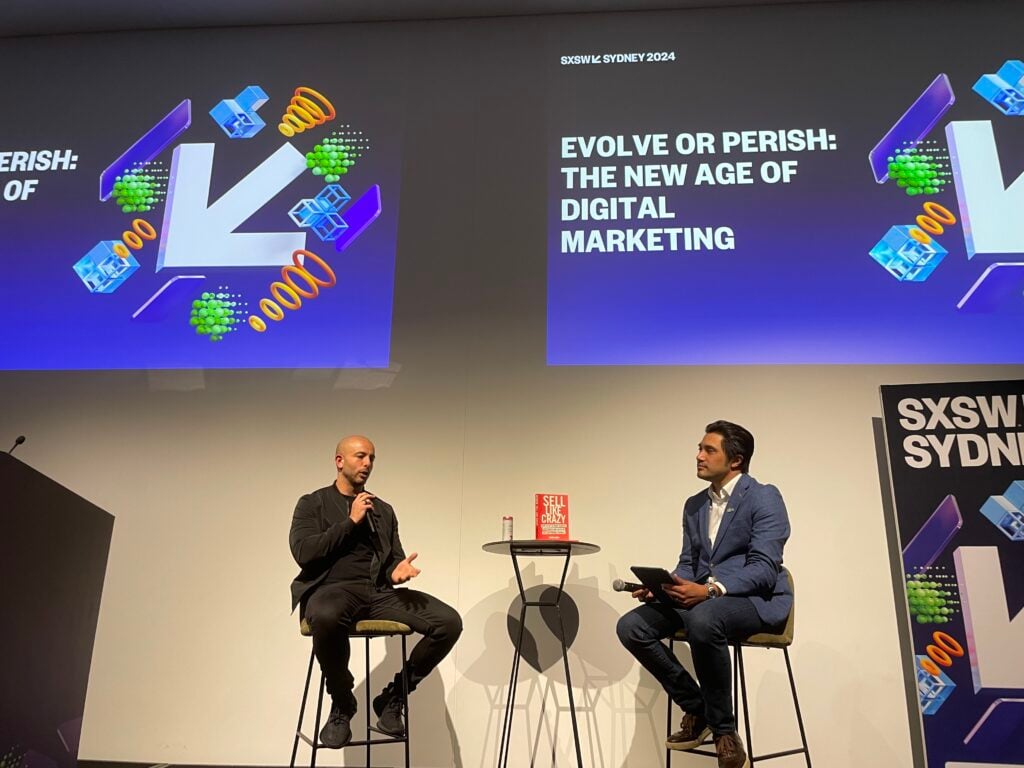
Sabri Suby and Damian Francis
Canva’s Melanie Perkins in Conversation with Mary Meeker
Canva CEO and co-founder, Melanie Perkins opened SXSW Sydney 2024 in the Darling Harbour theatre to a sizeable crowd, detailing the journey of Canva from its origins in 2007 with a yearbook creation platform to a global design platform, which now records 170 million monthly users and is valued at $26 billion.
Upon meeting her now husband and Canva co-founder, Cliff Obrecht at university, Perkins launched Fusion Books in 2007 with the tagline, “You don’t need a year to make a yearbook.” The idea behind the platform was to simplify the yearbook creation process, taking it online and making it collaborative.
By 2011, Fusion Books had grown rapidly, serving 250 schools by 2011 and in the same year, Perkins traveled to Silicon Valley to raise funds for a new idea, a platform that focused on making design accessible to non-designers.
Despite numerous rejections in securing investment, a remedy was found when Cameron Adams joined as the third co-founder of Canva, and the platform was officially launched in August 2013.

Canva’s Melanie Perkins with Mary Meeker at SXSW
Canva reached a million monthly active users within two years of launch, and its growth was largely organic, with 90% of new users coming through word-of-mouth and referrals. Perkins emphasised the fact that the company invested heavily in a free product early, while also investing in a paid product that offered great value, which she says contributed to its rapid growth.
Perkins further emphasised the importance of setting “crazy” goals and making them happen, which is a core value at Canva.
“To be frank, one of the philosophies that we try and bring to life as much as we possibly can is that as a company, we need to be competing against the world, not each other,” Perkins said.
“We really believe we should push out and expand the pie, versus trying to create some sort of structure that avoids that.” – JB
Shaping the Future of AI: Manohar Paluri, VP of AI at Meta in conversation with Ryan Patel
Manohar Paluri, VP of AI at Meta next took to the stage at the Darling Harbour Theatre alongside futurist Ryan Patel to discuss the evolution of AI at Meta and provided a vision for the future that includes a world where everyone can shape and build on AI models, including Meta’s own foundation model, Llama.
An audience member asked Paluri why people should develop on Llama compared to other options that are available. Paluri then launched into sales mode.
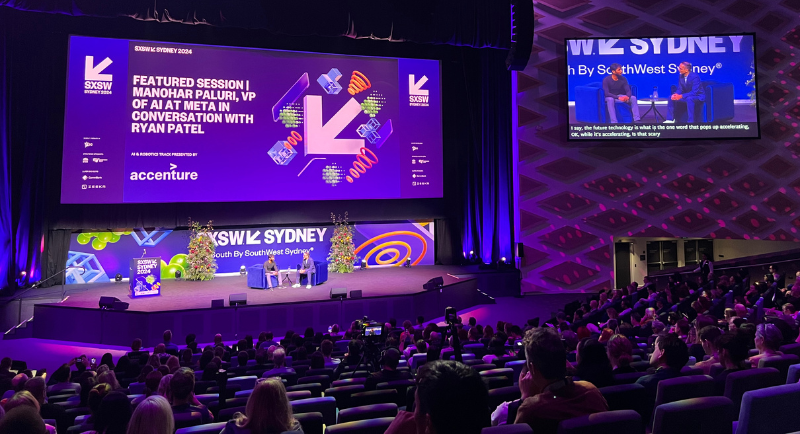
“Llama models are the most customisable models that you can get, period,” he said.
“It’s the most performant and cost-efficient model and if you look at the family of Llama models, there are close to 65,000 variants of Llama made across the world and 400 million downloads.
“When you build on a system that so many developers and so many variants across the world are pushing, you’re getting the benefits of it without your own additional effort. That’s a huge deal, that;s the power of open ecosystem, that’s the power of community rallying together to build on this standard and that’s why I think you should build on it.” – JB
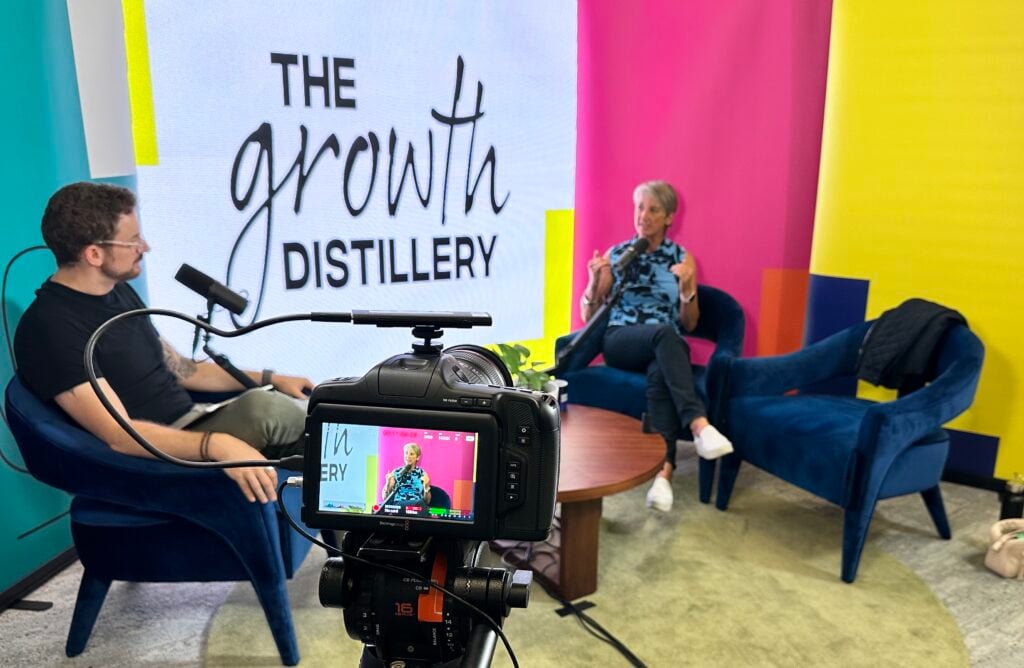
Layne Beachley at The Growth Distillery: ‘Don’t get stuck in fear’
First up early on Monday at The Growth Distillery’s Vodcast studio was Layne Beachley with Daniel Krigstein.
After discussing the power of fear, Krigstein asked Beachley how do you go about starting a counter-narrative.
“I talk about the three A’s,” replied the seven-time World Surfing Champion. “First is awareness, aware of how you’re feeling and if you’re feeling uneasy, then it’s about accepting that you are in that state. That’s the second A.
“Then be agile in your response to it. And when we go into that state of agility, it means that we’ve got a toolkit of action plans for different situations that require different actions. We can’t just rely on one action to power us or inspire us to move past it or to overcome it.
“Some things just can’t be overcome. And that’s okay. I feel the biggest mistake that I made, especially in my younger years, is that I didn’t acknowledge how I felt.
“Because I wasn’t willing to acknowledge it, I couldn’t build an awareness about it. You know, there’s all this talk about self-awareness and all of these things, but that comes with maturity and understanding and experience. The education system, when I came through it, certainly didn’t encourage you to embrace or engage with your feelings.”
Layne Beachley on breaking the rules
Daniel Krigstein asked Beachley about what she did differently.
“As a competitor, it was very easy to conform and do what everyone else was doing. My objective and one of my competitive advantages was I didn’t do what everyone else was doing. I saw what everyone was doing and found a way to do it differently.
“That enabled me to stay true to who I wanted to be and create a pathway for others to follow, as opposed to just following the same old pathway. Simple things, for example, showing up to a contest site, watching where the surfers before me were surfing and always looking for somewhere else to go. Having discussions with the judges, asking them about the conditions that they’re seeing. What are they looking for today that may be a little bit outside of the box? What do they want to see? And surfing according to how I wanted to surf versus what the judging criteria expected of me.
“Bringing in aspects of mindfulness and meditation, slowing everything down mentally so I could speed everything up physically.”
Firing the sponsor
“What else did I do? I think one of the biggest things that I did, and that was in accordance with my values system, was I dropped my sponsor.
“I’m one of the only athletes to have done that. I know Barton Lynch did the same thing to his sponsor in maybe the 80s or 90s. In 2004 I dropped my sponsor because of a values misalignment. A lot of people saw it as stupid because I walked away from hundreds of thousands of dollars in sponsorship and I’ve never been sponsored since. The motivation to do that came from asking them to meet me where I was, as opposed to pushing me to somewhere where I’m not really willing to go.” JM
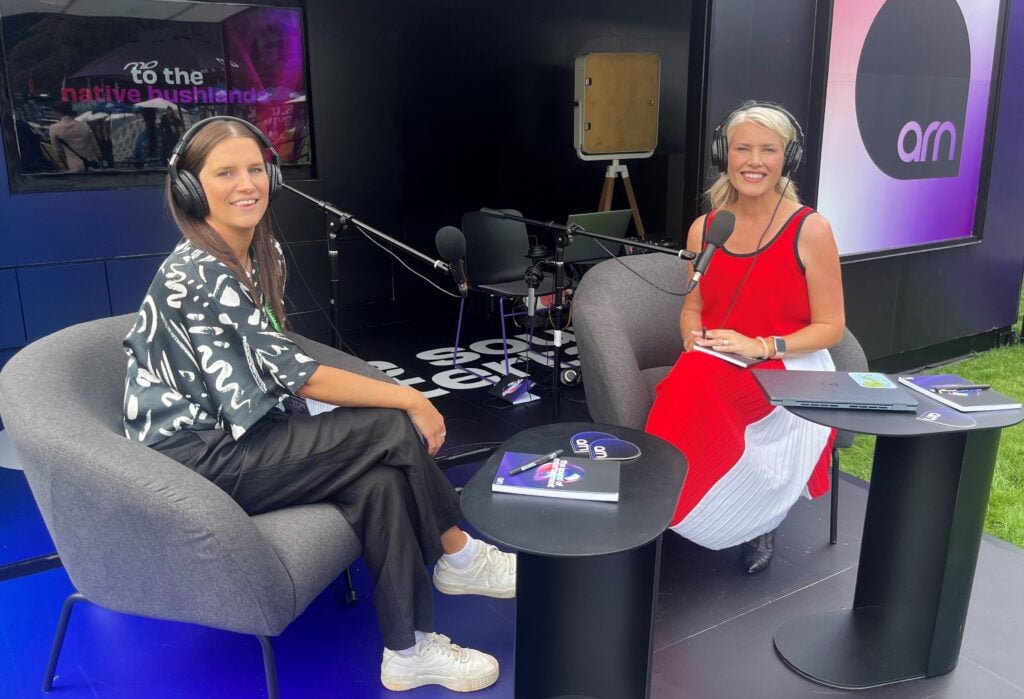
ARN head of news Fiona Ellis-Jones (right) with Head of client Strategy at ARN, Tegan Kirkby
ARN: The Sound of Entertainment
The radio and podcast company had a studio set up in the open in one corner of Tumbalong Park. iHeart was inviting people to use the studio to record their own 15-miniute podcast.
During the afternoon, ARN head of news for metro and regional, Fiona Ellis-Jones was recording podcasts too.
There’ll be more from the ARN Sound of Entertainment during the week including a Jonesy and Amanda podcast. This will be their first public appearance since another massive trophy haul of the ACRA Awards. JM

Land Rover Defender test drives
We didn’t have time to jump in a Defender on Day 1, but they are offering test drives of their new models. A potential purchaser is free to take a test vehicle on a drive over the Harbour Bridge or even to the coast. The Defender range starts around $80,000. But if you are tempted by the V8 in the centre of this photo you will need close to $250,000. The company was one of several auto brands displaying their vehicles at SXSW. JM
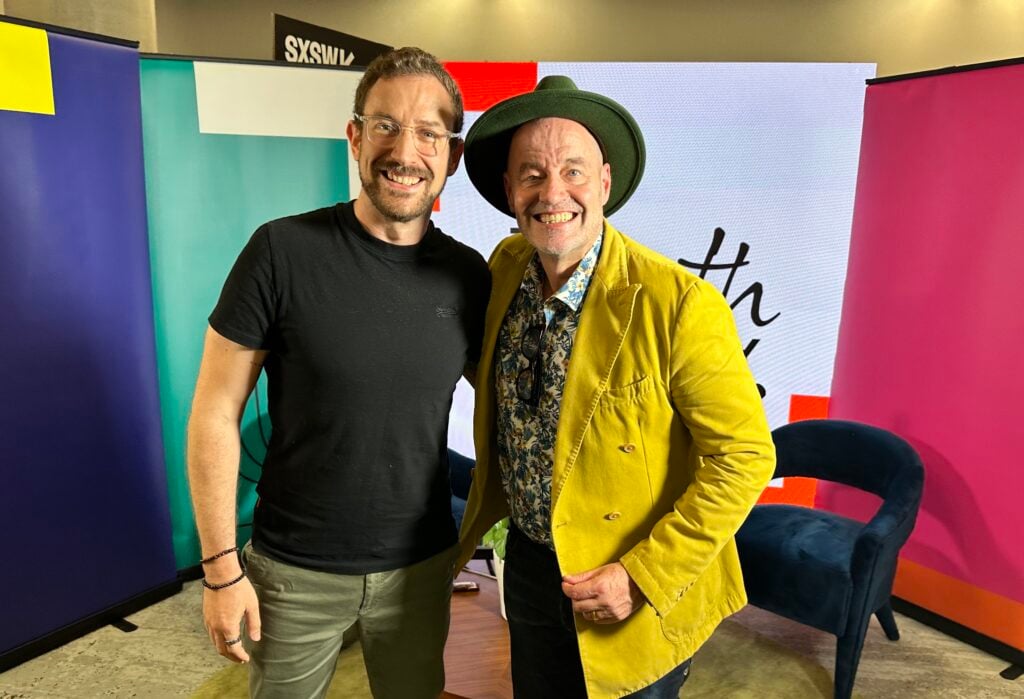
Adam Spencer: Breakfast host turned futurist
Many people will remember Adam Spencer from his days hosting Triple J breakfast and numerous appearances on ABC TV. However, these days you are more likely to catch him on the lecture circuit at events like, well, SXSW. This year his duties included The Growth Distillery podcast series The Rules Don’t Apply episode.
As we noted above, host Dan Krigstein’s first guest was Layne Beachley. For the second record on Monday Adam Spencer was talking about tearing up the rulebook. Spencer spoke about how he dropped out of a PHD course and fell into breakfast radio via a chance winning performance in a standup comedy competition.
We will have more about Spencer when the podcast episode drops soon. JM
See also: SXSW Blog Day 1: Sessions with Canva’s Melanie Perkins and Meta AI guru Manohar Palur

